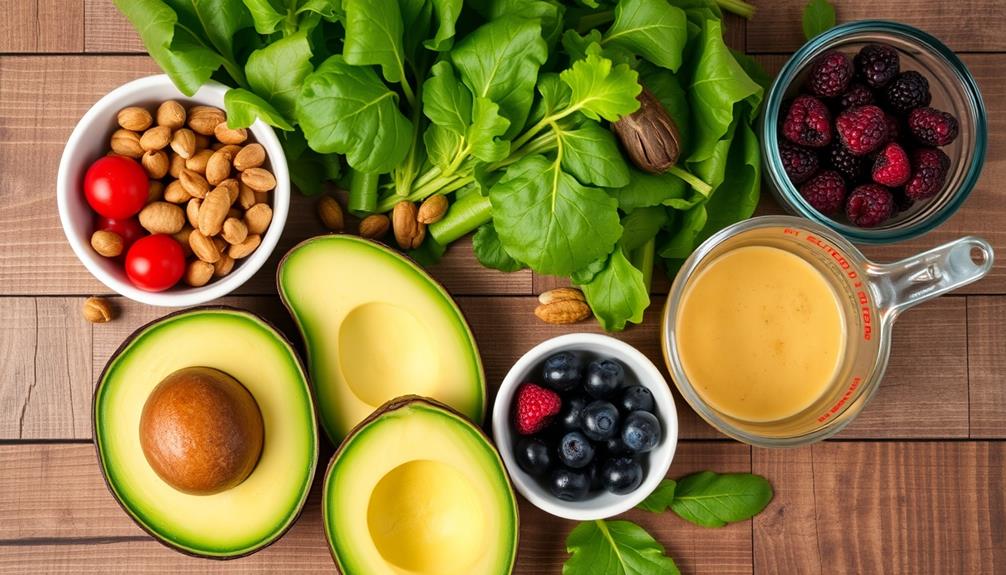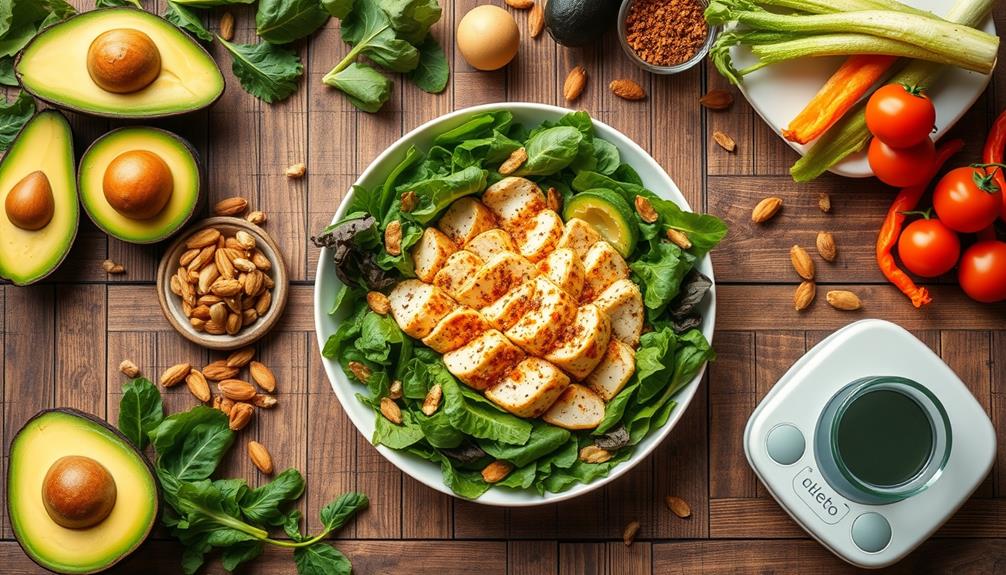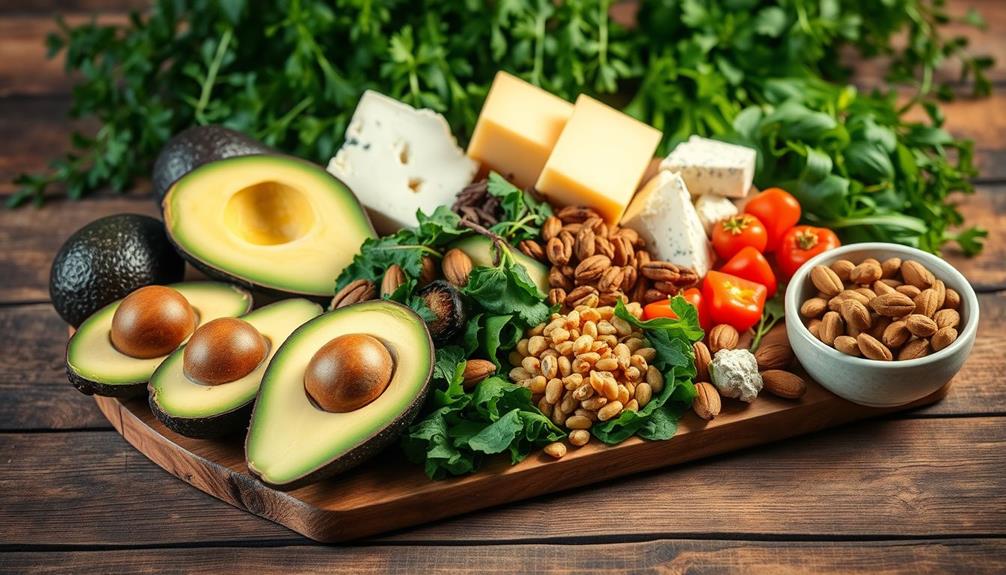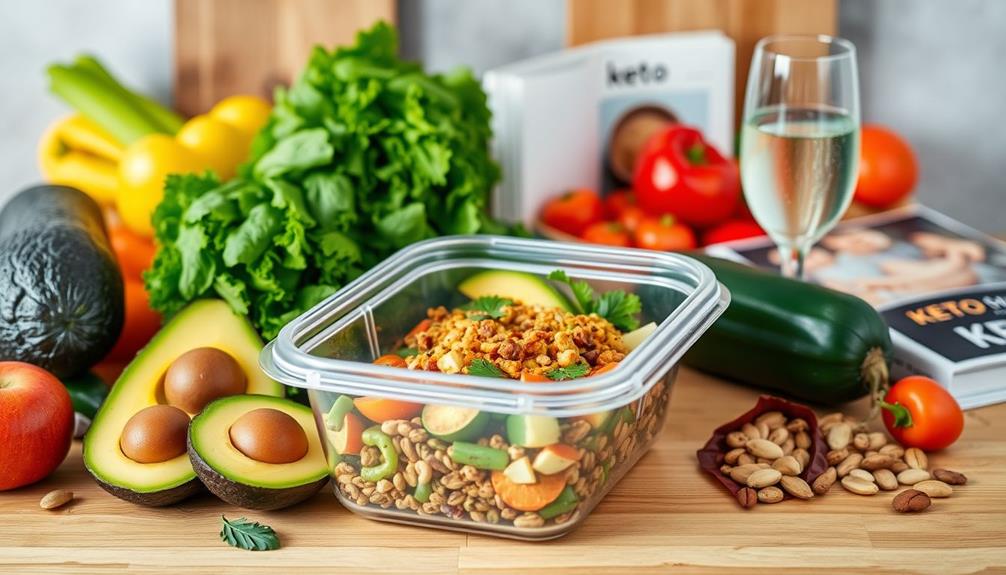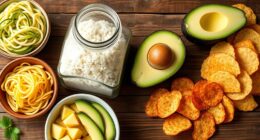You can typically include 20 to 50 grams of net carbs a day on the keto diet to maintain ketosis. This means you subtract dietary fiber and half of sugar alcohols from your total carbs. Sticking to this limit helps your body shift from using glucose for energy to burning fat instead. Focus on low-carb veggies and high-fat foods while avoiding grains and starchy items. Remember, individual tolerances may vary based on your activity level and metabolic health. If you want to know more about how to optimize your carb intake and achieve ketosis, there's plenty more to uncover.
Key Takeaways
- The ketogenic diet typically limits net carbohydrate intake to 20-50 grams per day to maintain ketosis.
- Net carbs are calculated by subtracting fiber and half of sugar alcohols from total carbohydrates.
- Individual tolerance for carbs may vary based on factors like activity level and metabolic health.
- Staying within the 20-50 gram range is crucial for effective fat burning and achieving nutritional ketosis.
- Regular monitoring of carbohydrate intake helps prevent hidden carbs from disrupting ketosis.
Overview of the Keto Diet
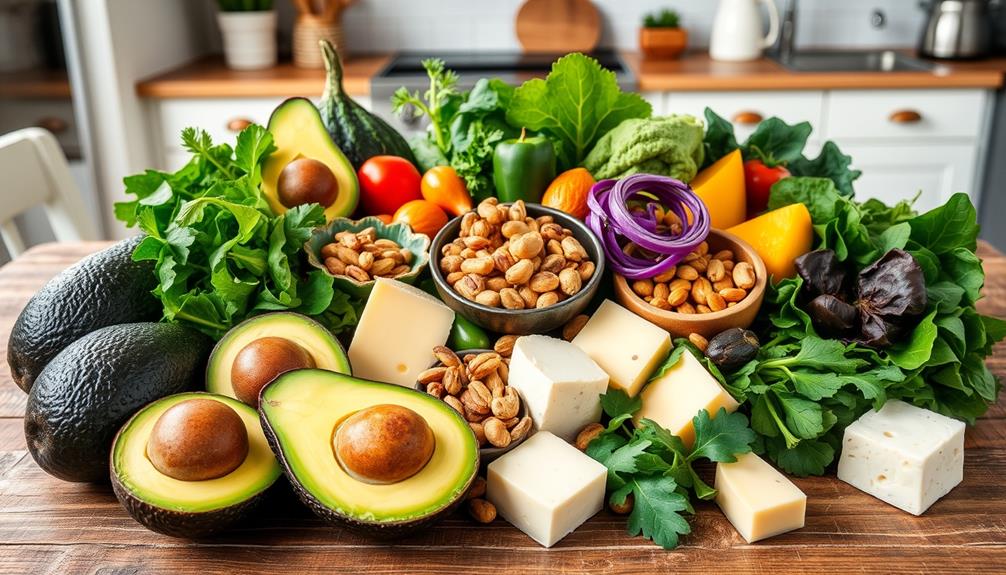
The ketogenic diet is a popular approach that greatly limits your carbohydrate intake, usually to under 50 grams of net carbs daily. This restriction is vital for inducing ketosis, a metabolic state where your body shifts from burning glucose for energy to utilizing fat stores.
The keto diet emphasizes a macronutrient ratio of approximately 70-80% fat, 5-10% carbohydrates, and 10-20% protein. This difference sets it apart from other low-carb diets, focusing heavily on fat as your primary energy source.
Additionally, it's significant to take into account the potential gastrointestinal effects of dietary changes, similar to those seen during juice cleanses, which may require adjustment periods. To enter and maintain ketosis, you need to deprive your body of glucose, which prompts it to produce ketones from stored fat.
While you might experience benefits like weight loss and increased energy, it's important to acknowledge the signs of ketosis, such as increased thirst, frequent urination, and, for some, bad breath.
To effectively monitor your carb intake while on the keto diet, you often calculate net carbs by subtracting fiber and sugar alcohols from total carbohydrates. This practice helps you stay within your carbohydrate limits, ensuring you maintain the state of ketosis effectively.
Understanding Carbohydrate Limits
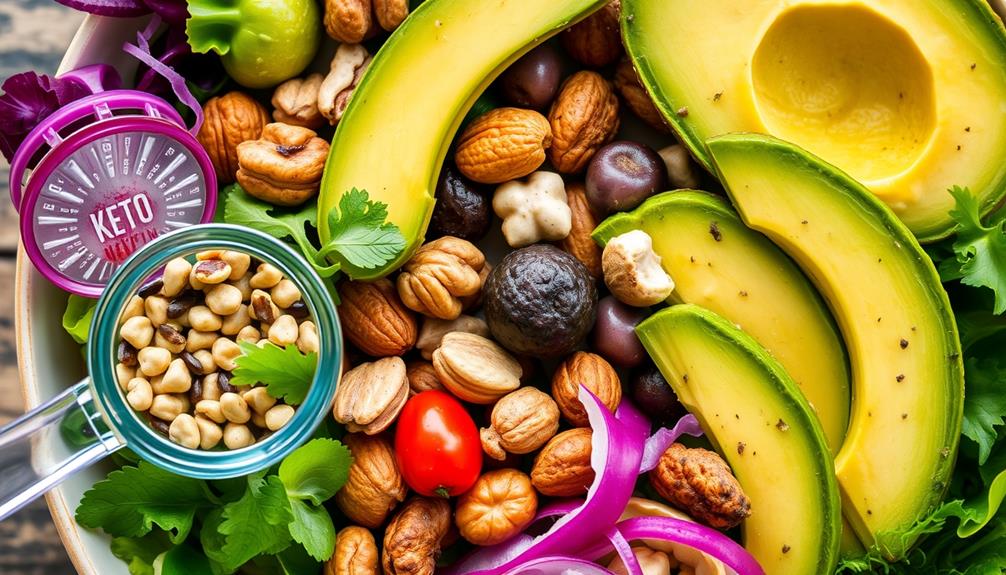
Understanding carbohydrate limits is vital when following the keto diet, as it directly impacts your ability to achieve and maintain ketosis. Typically, you should aim for a carbohydrate restriction of 20 to 50 grams of net carbs per day. This limit helps your body shift from burning glucose to burning fat for fuel.
Maintaining a balanced diet and incorporating regular exercise can further enhance your keto experience, as these practices support overall health and longevity. Net carbs are calculated by subtracting dietary fiber and half of the sugar alcohol content from the total carbohydrates in a food item. By focusing on net carbs, you can make more informed choices about what to eat.
It's important to consistently monitor your net carb intake because exceeding your limit can prevent you from entering or staying in ketosis.
Most people on the keto diet work towards a macronutrient ratio of about 5-10% carbohydrates, 70-80% fats, and 10-20% protein. Keep in mind that individual carbohydrate tolerance varies based on factors like activity level, body composition, and metabolic health.
As a result, you may need to adjust your carb intake to find what works best for you while adhering to your keto goals. Additionally, effective strategies for weight loss can help you stay motivated and make sustainable dietary changes.
Role of Net Carbs
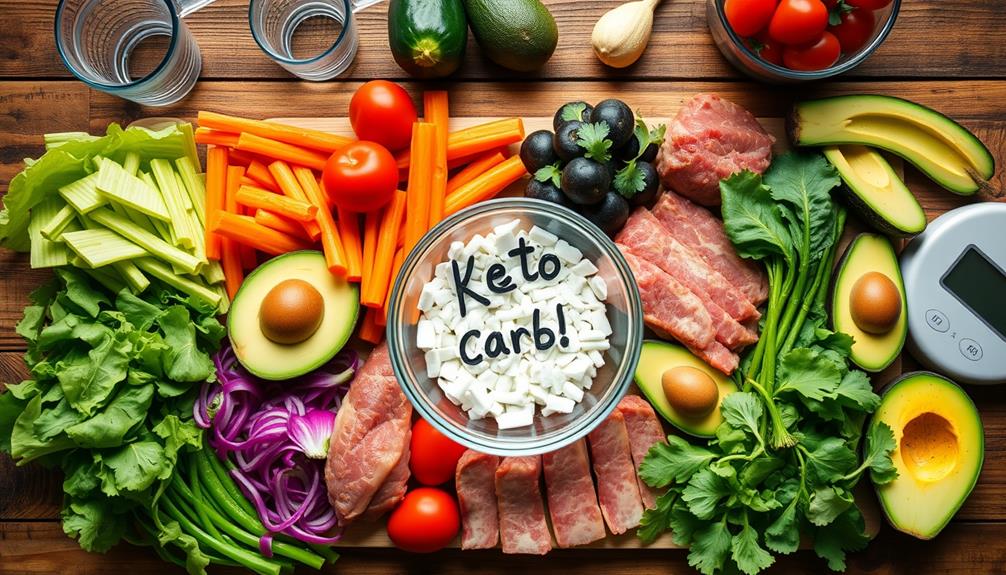
On a keto diet, net carbs play an essential role in achieving and maintaining ketosis. To stay in this state, you typically limit your daily intake of net carbs to 20-50 grams. Understanding your overall financial health is similarly vital, as managing your budget can help you allocate funds effectively for your dietary needs and goals, such as creating a personal budget.
But what exactly are net carbs? Simply put, net carbs are calculated by subtracting dietary fiber and half of the sugar alcohols from the total carbohydrate content of a food item. This approach helps you focus on foods that won't spike your blood sugar levels or trigger insulin responses.
Tracking net carbs accurately is vital for adhering to ketogenic diets. When you prioritize low carbohydrate diet options, you can effectively support your body in burning fat for energy.
High-fiber, low-fructose fruits and non-starchy vegetables can be included in moderation, as they contribute to your fiber intake while keeping net carb counts low.
Foods to Include and Avoid

When you're on a keto diet, focus on high-fat foods like avocados, nuts, and oils while loading up on low-carb veggies such as leafy greens.
It's also important to take into account the role of hydration in maintaining your energy levels and overall health during this dietary shift.
You'll want to steer clear of grains, starchy vegetables, and most fruits to keep your carb intake low.
Understanding what to include and avoid is key to maintaining ketosis and reaching your goals.
Approved High-Fat Foods
Choosing the right foods is essential for successfully following a ketogenic diet, as it emphasizes high-fat, low-carb options. Incorporating approved high-fat foods into your meals will help you stay within your net carbs per day while enjoying delicious flavors.
Focus on avocados, olive oil, nuts, seeds, and fatty fish. These foods not only provide healthy fats but also keep your carb counts low, aligning with your low-carb diet goals. Additionally, incorporating essential oils for health can support your overall well-being during your ketogenic journey.
On the other hand, you need to avoid high-carb foods that can easily derail your progress. Steer clear of grains, sugars, starchy vegetables like potatoes and corn, and most fruits. Instead of high-carb fruits like bananas and grapes, choose low-carb alternatives such as berries, which typically contain fewer than 10 grams of net carbs per serving—perfect for satisfying your sweet tooth in moderation.
It's also vital to prioritize whole food sources of fat, like grass-fed meats and full-fat dairy, to maintain the desired macronutrient ratio of 70-80% fat, 5-10% carbohydrates, and 10-20% protein.
Low-Carb Vegetable Options
Incorporating low-carb vegetables is a key strategy for maintaining your ketogenic diet while adding variety and essential nutrients to your meals. Focus on non-starchy vegetables, as they typically contain only 1-5 grams of net carbs per serving, making them ideal for a low carb diet.
Leafy greens like spinach, kale, and romaine lettuce are particularly beneficial; romaine has less than 1 gram of net carbs per cup, providing fiber without compromising your carb limit. Additionally, understanding the impact of certain beverages, such as coffee, on your keto diet can be important, especially since different brewing methods can affect caffeine levels and overall health benefits various brewing methods.
Other great options include broccoli, zucchini, bell peppers, cucumbers, and cauliflower, all of which help you keep your net carbs low while enriching your diet with vitamins and minerals. By choosing these vegetables, you not only support ketosis but also guarantee you're getting adequate nutrients for overall health.
As you plan your meals, remember to steer clear of high-carb vegetables like potatoes, sweet potatoes, and corn, which can contain 15-20 grams of net carbs per serving.
Foods to Avoid
To successfully navigate the ketogenic diet, you'll want to steer clear of high-carb foods that can quickly derail your progress. Consuming more than 20-50 grams of net carbs can hinder your ability to maintain ketosis, so knowing what to avoid is essential.
Here's a quick reference table for the foods to avoid:
| Food Category | Examples | Net Carbs per Serving |
|---|---|---|
| Grains | Bread, Pasta, Rice | 15+ grams |
| Starchy Vegetables | Potatoes, Corn | 20 grams |
| Sugary Beverages | Sodas, Fruit Juices | 30+ grams |
Measuring Ketosis Effectively

To measure ketosis effectively, you can use several methods like blood ketone meters, urine strips, and breath analyzers.
Each method has its own accuracy levels, so it's important to understand how to interpret your ketone readings.
Additionally, recognizing signs of ketosis can help you gauge your progress alongside these testing methods.
Understanding the benefits of choosing the best heat pump can also contribute to a more comfortable home environment, which is vital while maintaining a specific diet like keto.
Testing Methods Overview
Measuring ketosis accurately is essential for anyone on a ketogenic diet, as it helps you confirm you're in the ideal fat-burning state. There are several testing methods available, each with its own pros and cons. Additionally, maintaining a clean environment can support your overall health, much like how air quality considerations can impact your well-being.
Urine test strips are a popular choice because they're cost-effective and easy to use. They measure acetoacetate levels but may become less reliable as your body adapts to ketosis over time.
If you're looking for precision, blood ketone meters are your best bet. These devices directly measure beta-hydroxybutyrate (BHB) levels in your bloodstream, providing the most accurate indication of ketosis. Ideal BHB levels typically range from 1.5 to 3.0 mmol/L.
If you prefer a non-invasive method, you might try breath analyzers. They detect acetone levels in your breath as an indirect measure of ketosis, offering convenience, though their accuracy can vary.
Regularly monitoring your ketone levels is essential for staying on track with your ketogenic diet and ensuring effective fat metabolism and weight loss. Choose the method that fits your lifestyle and preferences to make measuring ketosis a seamless part of your routine.
Interpreting Ketone Levels
Understanding how to interpret your ketone levels is key to guaranteeing you're effectively following the ketogenic diet. With the growing interest in health and wellness, many people are seeking guidance on diets like keto, which emphasizes low carbohydrate intake for fat burning.
To determine if you're in ketosis, you can use a blood ketone meter, with readings between 0.5 and 3.0 mmol/L indicating that you're achieving nutritional ketosis. While urine ketone strips provide a quick way to measure ketones excreted in your urine, keep in mind that they may lose accuracy over time.
AI Cybersecurity Jobs are vital in protecting personal health data as more individuals track their diets online. Breath analyzers are another option, measuring acetone levels; readings above 1.5 ppm typically signal a ketogenic state.
Regularly monitoring your ketone levels is essential for maintaining effective fat metabolism and weight loss. Remember, achieving and sustaining ketosis often requires you to keep your daily net carb intake below 50 grams.
If you exceed this limit, it can hinder your body's ability to produce ketones and utilize energy effectively. By understanding how to interpret your ketone levels and adjusting your net carb intake accordingly, you can optimize your ketogenic journey and guarantee you're on the right track toward your health goals.
Signs of Ketosis
Achieving ketosis is a significant milestone on your ketogenic journey, and recognizing its signs can help you confirm you're on the right track. When you reduce your daily carbohydrate intake to about 20-50 grams of net carbs, your body starts burning fat for fuel instead of glucose, leading to ketosis. This metabolic change can be influenced by various factors, including your overall health and dietary choices, which play a role in key domains of development.
You might notice increased thirst, frequent urination, and a distinctive fruity breath odor, often compared to nail polish remover. These signs indicate elevated acetone levels in your system. To measure ketosis effectively, checking your blood ketone levels is the most accurate method. Aim for levels between 0.5 to 3.0 mmol/L to confirm nutritional ketosis.
While urine ketone strips are an option, they can become less reliable as your body adapts to utilizing ketones for energy.
During the initial adjustment period, you may experience what's known as the "keto flu," which includes symptoms like fatigue and irritability. Remember, these feelings are temporary as your body shifts to its new energy source.
Common Mistakes to Avoid
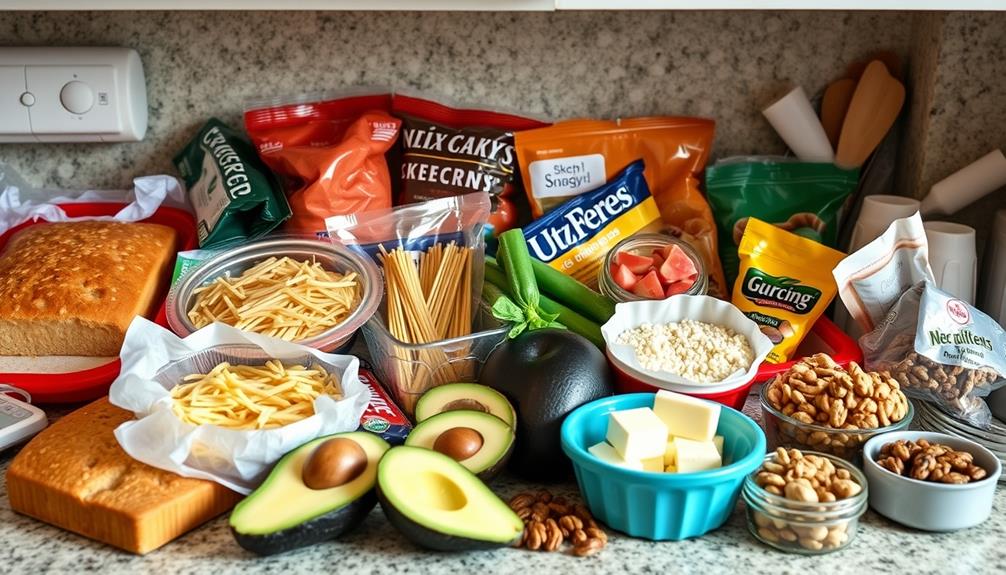
Many people diving into the keto diet make common mistakes that can derail their progress. To guarantee success, pay close attention to these pitfalls:
| Mistake | Consequence | Solution |
|---|---|---|
| Underestimating hidden carbs | Disrupts ketosis | Read labels and track all carb sources |
| Overconsumption of protein | Promotes gluconeogenesis | Keep protein intake at 0.7-0.9g/lb |
| Insufficient fat intake | Low energy and ketosis disruption | Aim for 70-80% of calories from fats |
| Neglecting hydration | Symptoms of "keto flu" | Drink plenty of water and consider electrolytes |
Monitoring net carbs is essential; make certain you subtract fiber and sugar alcohols from total carbs to stay within the 20-50 grams recommended. Hydration is often overlooked but fundamental for well-being. Don't let these mistakes hold you back from achieving your keto goals. Stay informed, track your intake diligently, and adjust your habits to support your journey effectively.
Long-Term Sustainability Tips
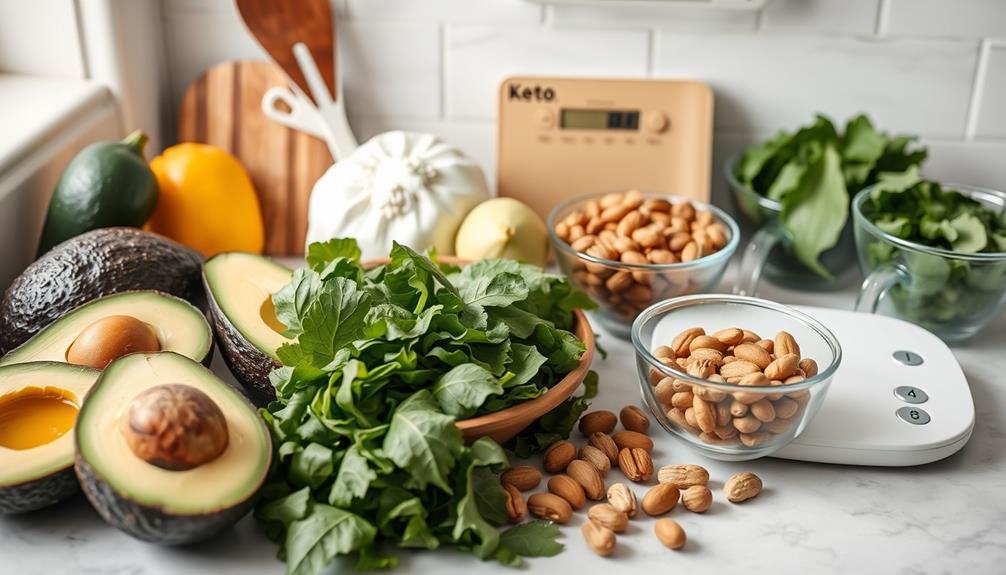
Maintaining a keto diet over the long term requires strategic planning and flexibility. To achieve long-term sustainability, consider gradually reintroducing carbs after reaching your weight loss goals. This helps you find a personal balance that supports your ongoing health and satiety.
Aim to keep your net carbohydrates between 20-50 grams per day while tracking your intake, which helps you stay in ketosis without feeling restricted. Additionally, understanding the financial considerations of dietary choices is important, as financial planning for assisted living can also relate to overall health management.
Incorporating a variety of keto-friendly foods is essential to combat dietary boredom. Focus on healthy fats, non-starchy vegetables, and low-carb snacks to keep your meals interesting and satisfying.
Staying hydrated is equally important; supplementing electrolytes like sodium, potassium, and magnesium can alleviate common side effects and improve your overall well-being.
Don't hesitate to seek guidance from a registered dietitian. They can provide personalized support, ensuring you're meeting your nutritional needs and addressing any deficiencies that may arise from the restrictions of low-carb diets.
Frequently Asked Questions
How Many Carbs Can I Eat and Stay in Ketosis?
To stay in ketosis, you'll typically want to limit your net carbs to about 20 to 50 grams daily. Monitoring your intake closely helps you maintain ketosis effectively while considering your individual factors.
Can You Lose Weight on 50 Carbs a Day?
Yes, you can lose weight on 50 carbs a day. By reducing your carb intake, you encourage your body to enter ketosis, burning fat for energy and promoting significant weight loss over time. Stick with it!
How Many Carbs to Be Kicked Out of Ketosis?
If you consume more than 50 grams of net carbs daily, you risk being kicked out of ketosis. It's crucial to monitor your intake closely, as even hidden carbs can disrupt your progress.
Can I Have 100 Carbs a Day on Keto?
You can't have 100 carbs a day on keto if you want to stay in ketosis. That amount typically hinders ketone production, making it harder for your body to burn fat effectively.
Conclusion
To summarize, finding the right carb limit on the keto diet is key to achieving your health goals. By focusing on net carbs and making mindful food choices, you can enjoy a variety of delicious meals while maintaining ketosis. Remember, it's not just about restriction; it's about creating a sustainable lifestyle. So, are you ready to embrace this low-carb journey and transform your relationship with food? Your path to better health starts now!
